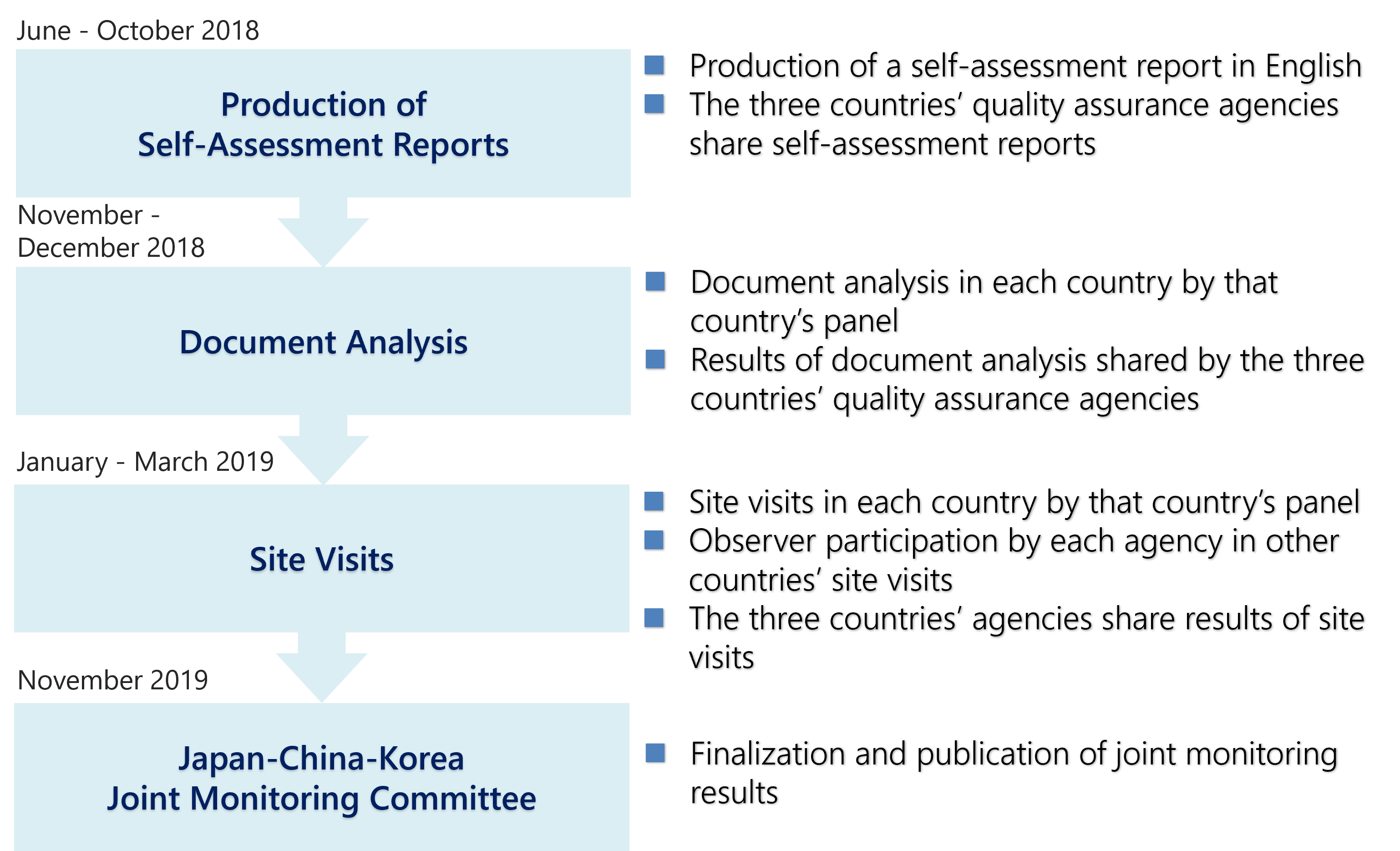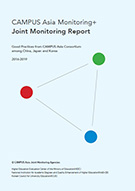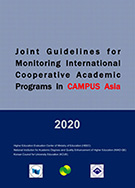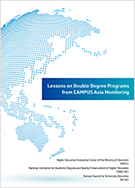Monitoring +
The quality assurance agencies in Japan (NIAD-QE), China (HEEC), and Korea (KCUE), conducted monitoring, namely "Monitoring+ (plus)," on 'CAMPUS Asia' full-fledged programs (Mode 2) during 2018-2019. Monitoring+ was conducted in accordance with the Joint Guidelines for Monitoring International Cooperative Academic Programs in 'CAMPUS Asia' developed after the implementation of the second monitoring.
- Implementation Structure and Procedures
- Joint Monitoring Criteria
- Joint Monitoring Report
- Joint Guidelines (2nd Edition)
- Lessons on Double Degree Programs
* HEEC changed its name to "Education Quality Evaluation Agency" (EQEA) in 2022.
Implementation Structure and Procedures
For Monitoring+ activities, 'CAMPUS Asia' joint monitoring committee and joint monitoring panels were established, following the method of the second monitoring. These panels were comprised of Japanese, Chinese, and Korean academic experts with knowledge on the internationalization of higher education and international collaborative programs, as well as representatives from quality assurance agencies.
The panel assessed that the previous two monitoring initiatives were successful in developing a framework for quality assurance and deepened the mutual trust between the quality assurance agencies in Japan, China, and Korea. Consequently, as seen below, each of the three countries' quality assurance agencies was responsible for monitoring three of the nine programs.
- Japan - NIAD-QE:The University of Tokyo, Osaka University, Waseda University
- China - HEEC:Tokyo Gakugei University, Tokyo University of Marine Science and Technology, Nagasaki University
- Korea - KCUE:Chiba University, Tokyo University of the Arts, Kyushu University ※ The universities listed above are the Japanese institutions participating in the consortium monitored by each quality assurance agency.
The process for the Monitoring+ is shown in the figure below.

Joint Monitoring Criteria
The joint monitoring criteria for Monitoring+ were identical to those for the second monitoring, apart from Criterion 5, revised as "Continuous Quality Improvement," with no sub-criteria.
| Criteria | Sub-criteria |
|---|---|
| 1. Objectives and Implementation | 1.1. Achievement of Objectives 1.2. Organization and Administration |
| 2. Collaborative Development of Academic Program | 2.1. Curriculum Integration 2.2. Academic Staff and Teaching |
| 3. Student Support | 3.1. Student Admission 3.2. Support for Learning and Living |
| 4. Added-value of the Collaborative Program (Outcomes) | 4.1. Student Satisfaction 4.2. Credit Transfer and Degree Awarding |
| 5. Continuous Quality Improvement | |
Joint Monitoring Report

CAMPUS Asia Monitoring+ Joint Monitoring Report
('CAMPUS Asia' Joint Monitoring Committee, December 2019)
This is the final report of Monitoring+, which collected good practices of international collaborative programs and elaborated expectations for further efforts by universities in Japan, China, and Korea. The report centers on 104 examples of good practices in the 'CAMPUS Asia' programs identified through Monitoring+. It also describes other examples of good practices from the second monitoring in 2016. This report provides the outcome of monitoring activities to date comprehensively.
Joint Guidelines (2nd Edition)

Joint Guidelines for Monitoring International Cooperative Academic Programs in CAMPUS Asia (Second Edition)
(NIAD-QE, HEEC, KCUE, 2020)
This version of the guidelines is a revision of the first published edition of June 2017 and is based on the experiences from the last three monitoring rounds. It outlines the joint monitoring criteria and the methods for quality-assured international collaborative programs, with some details of the actual Monitoring+ activities. It also contains other useful information for those involved in international collaborative education programs, such as the differences in academic calendars between Japan, China, and Korea.
Lessons on Double Degree Programs

Lessons on Double Degree Programs from CAMPUS Asia Monitoring
(NIAD-QE, HEEC, KCUE, July 2021)
This publication focuses on double degree programs, which have become an important means of internationalization in East Asian universities, summarizing the knowledge on double degrees obtained from past monitoring activities. It also describes the outstanding efforts of universities reported in the "CAMPUS Asia Monitoring+ Joint Monitoring Report" published in December 2019. It explains the importance of double degree programs and provides tips on how to develop the programs by presenting the academic systems of Japan, China, and Korea.

